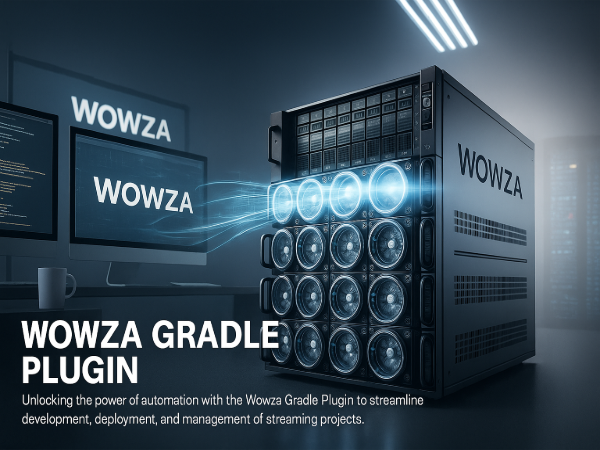Wowza Gradle Plugin: Simplifying Deployment and Automation for Streaming Applications
Unlocking the power of automation with the Wowza Gradle Plugin to streamline development, deployment, and management of streaming projects

The Wowza Gradle Plugin is a specialized tool designed to automate the building, packaging, and deployment of custom modules for the Wowza Streaming Engine. By integrating directly with Gradle, this plugin simplifies repetitive tasks, streamlines development workflows, and ensures consistent deployment across different environments. It helps developers save time, reduce errors, and maintain scalable, efficient streaming applications—making it an essential tool for teams working with high-demand video streaming solutions.
Introduction
In today’s digital era, video streaming dominates industries ranging from entertainment and media to education, healthcare, and enterprise solutions. Businesses and organizations rely heavily on robust platforms like Wowza Streaming Engine to deliver seamless, high-quality streaming experiences. However, one of the biggest hurdles in managing such platforms is the need to repeatedly perform time-consuming tasks like compiling, packaging, and deploying custom modules. This is where the Wowza Gradle Plugin comes into play.
Designed to work within the Gradle build system, the plugin automates routine processes, reduces human error, and enables faster deployment cycles. For developers and organizations aiming to scale efficiently, this plugin provides a powerful balance of convenience and control. In this article, we’ll explore the Wowza Gradle Plugin in detail, covering its features, setup, best practices, and how it can transform your streaming application development workflow.
What is the Wowza Gradle Plugin?
The Wowza Gradle Plugin is an open-source tool developed to bridge the gap between the Wowza Streaming Engine and the modern automation ecosystem provided by Gradle. It extends Gradle’s functionality by adding tasks specific to Wowza, allowing developers to:
Compile and package modules.
Deploy applications to Wowza servers automatically.
Restart, stop, and manage Wowza services directly from the build script.
Handle dependencies and configurations consistently across environments.
This plugin effectively turns repetitive and manual processes into seamless, automated workflows—ideal for both small-scale projects and large enterprise systems.
Why Automation is Crucial for Streaming Applications
Streaming applications demand consistency, speed, and reliability. Developers often work with frequent updates, feature testing, and environment migrations. Without automation, they face challenges like:
Manual Errors: Copying files, configuring servers, and managing dependencies manually can easily lead to mistakes.
Time-Consuming Deployments: Every build or deployment requires repeating the same steps.
Lack of Scalability: Manual processes can’t keep pace with rapid development or scaling needs.
Inconsistent Environments: Development, staging, and production often become misaligned, creating avoidable bugs.
The Wowza Gradle Plugin solves these issues by automating repetitive tasks and enforcing consistent, reliable practices across the board.
Key Features of the Wowza Gradle Plugin
Automated Deployment
Developers can deploy modules directly from their Gradle project without manually copying files into Wowza’s directories. This speeds up workflows and minimizes downtime.
Task Management
The plugin provides ready-to-use tasks such as:
build: Compiles and packages modules into JAR files.
deploy: Deploys the application and configuration files to Wowza.
restartWowza: Restarts the Wowza service after deployment.
stopWowza and startWowza: Control Wowza Streaming Engine directly.
Dependency Handling
Gradle is already known for powerful dependency management. By leveraging this, the plugin ensures your Wowza modules and third-party libraries are properly included and versioned.
Cross-Platform Support
It works seamlessly on Windows, Linux, and macOS, making it a versatile solution for teams with diverse development setups.
Logging and Error Tracking
Real-time logs help developers troubleshoot deployment or build issues immediately, reducing downtime and improving productivity.
Setting Up the Wowza Gradle Plugin
Setting up the Wowza Gradle Plugin requires only a few steps:
Add the Plugin Dependency: Define the plugin inside your Gradle build script, specifying the appropriate version.
Configure the Wowza Path: Point the plugin to your local Wowza Streaming Engine installation. This ensures that your compiled modules are deployed to the correct location.
Define Deployment Targets: Add configuration details for the applications you want to deploy. This could include custom XML files, libraries, or modules.
Execute Tasks: Use Gradle commands like gradle build, gradle deploy, or gradle restartWowza to manage your entire lifecycle from one place.
Best Practices for Using the Wowza Gradle Plugin
Pin Stable Versions
Always specify a fixed plugin version in your build script to avoid unexpected behavior due to updates.
Centralize Configurations
Keep your Wowza server details, ports, and deployment paths in one centralized location. This prevents environment mismatches.
Test Before Production
Deploy to a staging environment first. Automation ensures consistency, but testing safeguards against unforeseen issues.
Use Incremental Builds
Take advantage of Gradle’s caching and incremental build features for faster development cycles.
Monitor Logs Regularly
Enable detailed logging during deployments. This will help you catch issues early and maintain system reliability.
Real-World Benefits of the Wowza Gradle Plugin
Reduced Development Time: Automating builds and deployments frees developers to focus on creating features instead of handling repetitive tasks.
Increased Reliability: Consistent, error-free deployments lead to fewer production issues.
Improved Collaboration: Teams working on shared projects can maintain uniform configurations across environments.
Scalability: Large organizations with multiple streaming applications can scale faster without adding unnecessary complexity.
Common Challenges and How to Overcome Them
Dependency Conflicts: Ensure Gradle dependency management is used correctly to avoid version mismatches.
Environment Mismatches: Always verify that your local, staging, and production servers are aligned.
Learning Curve: New users may need time to familiarize themselves with Gradle tasks, but documentation and examples make onboarding easier.
Future of the Wowza Gradle Plugin
As streaming continues to expand across industries, automation tools like the Wowza Gradle Plugin will become even more important. Future improvements may focus on:
Tighter integration with cloud deployment services.
Enhanced logging and analytics capabilities.
Better support for CI/CD pipelines.
With the rise of DevOps practices, the plugin’s role in modernizing streaming workflows will only grow.
Conclusion
The Wowza Gradle Plugin is more than just a convenience—it’s a game-changer for developers and organizations working with the Wowza Streaming Engine. By automating repetitive tasks such as building, deploying, and restarting services, it ensures consistency, saves time, and enables teams to deliver high-quality streaming experiences faster.
Whether you’re a developer creating custom modules or an enterprise managing large-scale streaming solutions, adopting the Wowza Gradle Plugin can significantly enhance productivity and reliability. In a digital world where streaming is everywhere, this tool provides the automation edge every team needs.



